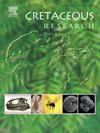Vertebrate coprolites from the marine Upper Cretaceous of Coimbra (west-central Portugal): Palaeoenvironmental and palaeoecological significance
IF 1.7
3区 地球科学
Q1 GEOLOGY
引用次数: 0
Abstract
A collection of 123 non-spiral vertebrate coprolites collected in the Tentúgal Formation from the middle Cenomanian, near Casais dos Carecos (Coimbra, west-central Portugal) is classified into eight different morphotypes (A to H) based on their morphology, size, poles shape, structure, and surface texture. The coprolites are autochthonous or parautochthonous, usually well-preserved without signs of abrasion or significant deformation. Each displays a uniform colouration, with hues ranging smoothly from yellow to reddish-yellow across the assemblage, and show low prevalence of surface traces, reflecting fast burial and a fossilization process under consistent environmental conditions. The calcium-phosphate composition of the coprolites, along with the presence of macro inclusions of bone elements in some specimens, indicates that they were produced by carnivores. The larger coprolites with circumferential constriction could be related to the crocodylomorphs. Other possible producers were marine squamates and teleosts. This study provides more insights into the Cretaceous marine and marginal marine ecosystems of the Aptian-Turonian West Portuguese Carbonate Platform, contributing to our understanding of the palaeoenvironmental conditions and food web interactions within this shallow epicontinental sea from the south European branch of the Tethyan realm.
科英布拉(葡萄牙中西部)海相上白垩纪脊椎动物粪化石:古环境和古生态意义
在葡萄牙中西部科英布拉Casais dos Carecos附近的Tentúgal组收集了123件非螺旋脊椎动物粪化石,根据它们的形态、大小、极点形状、结构和表面纹理,将它们分为8种不同的形态类型(A到H)。粪化石是原生或准原生的,通常保存完好,没有磨损或明显变形的迹象。每一个都显示出统一的颜色,在整个组合中,从黄色到红黄色的色调平滑地变化,并且显示出低流行的表面痕迹,反映了在一致的环境条件下快速埋葬和石化过程。粪化石的磷酸钙组成,以及一些标本中骨骼元素的宏观包裹体的存在,表明它们是由食肉动物产生的。具有周向收缩的较大粪化石可能与鳄鱼类有关。其他可能的生产者是海洋鳞片动物和硬骨鱼。这项研究提供了更多关于阿普提安-图尔onian西葡萄牙碳酸盐岩台地的白垩纪海洋和边缘海洋生态系统的见解,有助于我们了解来自特提斯王国南欧分支的浅陆表海的古环境条件和食物网相互作用。
本文章由计算机程序翻译,如有差异,请以英文原文为准。
求助全文
约1分钟内获得全文
求助全文
来源期刊

Cretaceous Research
地学-地质学
CiteScore
4.10
自引率
19.00%
发文量
235
审稿时长
12 weeks
期刊介绍:
Cretaceous Research provides a forum for the rapid publication of research on all aspects of the Cretaceous Period, including its boundaries with the Jurassic and Palaeogene. Authoritative papers reporting detailed investigations of Cretaceous stratigraphy and palaeontology, studies of regional geology, and reviews of recently published books are complemented by short communications of significant new findings.
Papers submitted to Cretaceous Research should place the research in a broad context, with emphasis placed towards our better understanding of the Cretaceous, that are therefore of interest to the diverse, international readership of the journal. Full length papers that focus solely on a local theme or area will not be accepted for publication; authors of short communications are encouraged to discuss how their findings are of relevance to the Cretaceous on a broad scale.
Research Areas include:
• Regional geology
• Stratigraphy and palaeontology
• Palaeobiology
• Palaeobiogeography
• Palaeoceanography
• Palaeoclimatology
• Evolutionary Palaeoecology
• Geochronology
• Global events.
 求助内容:
求助内容: 应助结果提醒方式:
应助结果提醒方式:


